#double empathy problem
Text
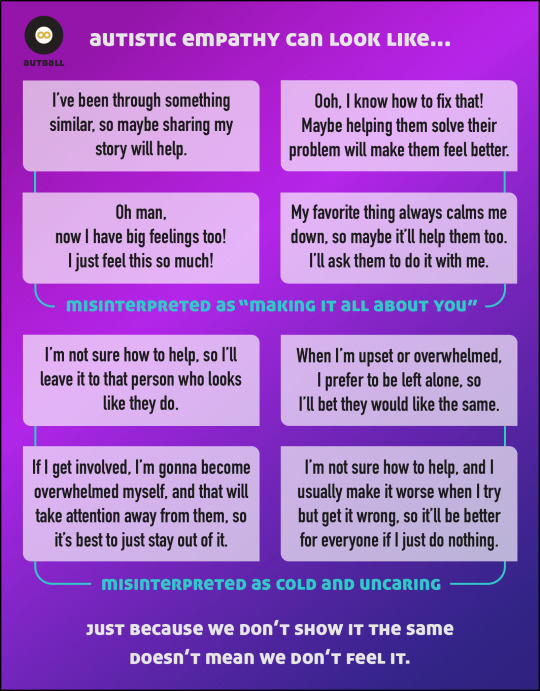
A non-exhaustive list of the ways autistic people may show empathy even though we are assumed to not have it.
Are these exclusive to autistic people? No, not at all, we're just more often pathologized for them.
If I'm in a relationship with someone who does this, does that mean I just have to suck it up even if it doesn't work for me? No, it doesn't, but you do probably have some adjusting to do. You'll need to treat it as a mutual miscommunication instead of something it's all on the autistic (or ADHD, or whatever) person to fix. You'll have to change some of your expectations and get comfortable asking for (and explaining) the show of empathy you need - and you may even find out that the way you show empathy isn't working so great for them either. 😉
[Image description: AUTISTIC EMPATHY CAN LOOK LIKE… - Infographic by Autball.
White translucent boxes with black lettering inside on a magenta to purple diagonal gradient. The first four boxes read: (1) I’ve been through something similar, so maybe sharing my story will help; (2) Ooh, I know how to fix that! Maybe helping them solve their problem will make them feel better; (3) Oh man, now I have big feelings too! I just feel this so much!; (4) My favorite thing always calms me down, so maybe it’ll help them too. I’ll ask them to do it with me. These four are grouped together with a blue line and labeled: Misinterpreted as “Making it All About You.”
The next four boxes read: (5) I’m not sure how to help, so I’ll leave it to that person who looks like they do; (6) When I’m upset or overwhelmed, I prefer to be left alone, so I’ll bet they would like the same; (7) If I get involved, I’m gonna become overwhelmed myself, and that will take attention from them, so it’s best to just stay out of it; (8) I’m not sure how to help, and I usually make it worse when I try but get it wrong, so it’ll be better for everyone if I just do nothing. These four are grouped together with a blue line and labeled: Misinterpreted as Cold and Uncaring.
At the bottom is one last sentence, in white bold lettering, that reads, “Just because we don’t show it the same doesn’t mean we don’t feel it.”]
#autism#autistic#actually autistic#autistic problems#autistic experiences#autistic artist#autistic feels#autism acceptance#neurodivergence#double empathy problem#empathy
19K notes
·
View notes
Text
it feels very unfair to be highly masking autistic with linguistic / sociolinguistic / communication special interests bcs you sure as hell put 200% effort to understand neuro-conforming people
yet these people barely spare or give you the benefit of the doubts IT IS EXHAUSTING AS HECK
194 notes
·
View notes
Text
Diagnostic Criteria for Allism Spectrum Disorder
also known as, Neurotypical Disorder
(Parody)
To meet diagnostic criteria for Allism Spectrum Disorder according to DSM-5, a child must have persistent deficits in each of three areas of social communication and interaction (see A.1. through A.3. below) plus at least two of four types of restricted, repetitive behaviors (see B.1. through B.4. below).
A. Persistent deficits in direct, honest, and compassionate social interaction and patterns of using deception and manipulation of others perception. Deficits persist across multiple contexts, as manifested by the following, currently or by history (examples are illustrative, not exhaustive; see text):
Deficits in social-emotional reciprocity. For example,
a. Indirect, ambiguous, or deceptive communication style,
b. Over dependence on social norms and generalizations,
c. Frequently superimposes subtext or places unfounded meaning on concrete, literal, or factual communication,
d. Struggles with comprehending consent and personal boundaries in social interaction.
Deficits in verbal and nonverbal communicative behaviors used for social interaction. For example,
a. Ritualized use of unusual or menial conversation topics (e.g. comments on weather),
b. Pervasive passive aggressive communication style (saying “that’s different” when really meaning “I don’t like that”),
c. An excessive use of eye contact, abnormalities in body language, and deficits in understanding and use of gestures.
Deficits in theory of mind and developing, maintaining, and understanding autistic relationships. For example,
a. Difficulties adjusting behavior to suit various social contexts,
b. Inappropriate or undesired responses in conversation (e.g. using repeated passive/apathetic responses to end a conversation, visible discomfort when your interests or opinions vary from theirs),
c. Absorption in perceived social status “ranking”,
d. Deficit in comprehending bodily autonomy and personal space,
e. Restrictive fixation with and dependence on gender social constructs,
f. Repeatedly engages in tribalistic behaviors, such as compulsive attempts to control reputation in groups, and exploiting, marginalizing, or punishing groups deemed unworthy or inferior.
Severity is based on social communication impairments and impairment in organized, specialized behavior. For either criterion, severity is described in 3 levels: Level 3 – requires very substantial support, Level 2 – Requires substantial support, and Level 1 – requires support.
B. Patterns of over-dependence on heuristics, social norms, and generalizations in behavior, interests, or activities, as manifested by at least two of the following, currently or by history (examples are illustrative, not exhaustive; see text):
Stereotyped or repetitive verbalization, use of objects, or speech. e.g.,
a. Simple motor stereotypes,
b. Repetitive vocal stimming via verbalizing unfiltered thoughts or patterns of erroneous intonation
c. Recreating social scenarios with toys or objects as children,
d. Repetitive use of involuntary scripted phrases (e.g. “Lets hang out soon”, “How are you”, “Long time no see”, or “It’s nice to meet you”).
Insistence on sameness, extreme adherence to pre-existing social norms, or ritualized patterns of verbal or nonverbal behavior. e.g.,
a. Ritualized use of indirect communication,
b. Strong attachment to group identity, rigid thinking patterns, greeting rituals,
c. Need to conform,
d. Difficulty in challenging pre-existing constructs in the world,
e. Gullible to group biases such as bandwagon effect, groupthink, or status quo bias.
Lack of specialization or pattern-recognition that is abnormal in apathy or disorderliness. e.g.,
a. numerous superficial, shallow hobbies and interests with deficit in or complete lack of deeper exploration of interests,
b. selecting interests based on social group or social influence,
c. utilizing interests as social currency without genuine passion,
d. ignoring small details because they do not align with expectations, context, or pre-existing beliefs,
e. overly concerned with social perception instead of concrete objects or information.
Dulled or hyporeactive to sensory input or information that does align with pre-existing knowledge, beliefs, or self-interest. e.g.,
a. ”tuning out” sounds in environment deemed unimportant,
b. easily influenced to interpret information based on how information is presented,
c. overly gullible to confirmation bias, halo effect, and attentional bias,
d. restrictively applyies existing social constructs as rules/expectations for all interaction and modelling of instead of generating beliefs based on sensory input and pattern recognition.
Specify current severity:
Severity is based on social communication impairments and restricted, repetitive patterns of behavior. (See table below.)
C. Symptoms must be present in the early developmental period (but may not become fully manifest until their behavior becomes intolerable to autistics).
D. Symptoms cause clinically significant impairment in social, occupational, or other important areas of current functioning.
E. These disturbances are not better explained by intellectual disability (intellectual developmental disorder) or global developmental delay. Intellectual disability and allism spectrum disorder frequently co-occur; to make comorbid diagnoses of allism spectrum disorder and intellectual disability, communication should be below that expected for general developmental level.
Note: Individuals with a well-established DSM-IV diagnosis of allism disorder, neurotypical disorder, or pervasive developmental disorder not otherwise specified should be given the diagnosis of allism spectrum disorder. Individuals who have marked deficits in social communication, but whose symptoms do not otherwise meet criteria for allism spectrum disorder, should be evaluated for social (pragmatic) communication disorder.
#double empathy problem#allistics#neurotypical#asd#autism#neurodivergent#actually autistic#audhd#autistic#neurodivergence#medicalization#dsm#dsm 5#allism#allistic awareness#double empathy#moomatahiko#naominoop#naominoop art
408 notes
·
View notes
Text
Six Things Educators Must Know About Neurodivergent People
Six Things Educators Must Know About Neurodivergent People
Here are six things we think every educator must know about neurodivergent people. By understanding these, we make “all means all” more meaningful.
Spiky Profiles
Monotropism
Double Empathy Problem
Rejection Sensitive Dysphoria
Exposure Anxiety
Situational Mutism
Table of ContentsSpiky ProfilesMonotropism & the Double Empathy ProblemExposure Anxiety, Rejection Sensitive Dysphoria, and…

View On WordPress
#double empathy problem#education#exposure anxiety#human centric education#love languages#monotropism#neurodiversity#rejection sensitive dysphoria#situational mutism
396 notes
·
View notes
Text
research only sampling a few late diagnosed/adult diagnosed, mostly verbal (include occasional lose speech), White autistics with lower support needs without intellectual disability is not good research that can be generalized to entire autistic population.
it is a biased sample. therefore the sample doesn’t reflect the whole population of all autistic people.
when hearing about research popular among online actually autistic community, like the double empathy problem/theory, don’t take things for granted.
just reading abstract and first paragraph of conclusion, skipping methods and limitation critique, etc. is reductionism!!
think: what is the author’s stance! what is the bias! what is the limitation!
#this is Stats thing i don’t know if i explained well enough for people without stats background#actually autistic#actuallyautistic#autism#double empathy problem#autistic#unrelated i am hungry#loaf screm
429 notes
·
View notes
Text
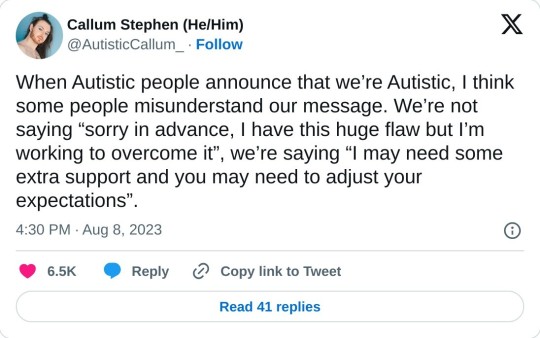
#twitter threads#AutisticCallum_@twitter#autism#actually autistic#social skills#double empathy problem#misunderstandings#op
51 notes
·
View notes
Text
Autistic/Allistic Communication: The Double Empathy Problem
The Double Empathy Problem and Theory of Mind
Autistic[1] and allistic (non-autistic) communication problems cut both ways. This is what’s known as the double empathy problem. However, communication issues between allistic and autistic communicators are usually blamed solely on the autistic person. Not only is this conception wrong, but it files in the face of much of the recent research.
The field of psychology (and others closely related to it) have been trying to study this problem for a really long time. It was originally thought to be a solely autistic issue with Simon Baron-Cohen, a prolific (and pretty ableist) autism researcher, saying that autistic people lack “Theory of Mind.” Theory of mind (TOM) is thought to be unique to humans, though there is some recent research showing theory of mind in other non-human primates and other animals, and is the idea that we have the notion that other people have minds that are different from our own with their own thoughts, opinions, and beliefs. There are many reasons why Baron-Cohen did not think autistic people have TOM, but the main one is that he misunderstands how autistic people think and communicate.
When interacting, autistics and allistics have different ideas of how the interaction should play out. These competing views lead to a lack of subjective empathy on both sides of the conversation due to the disparity in reciprocity. Termed the “double empathy problem,” social “deficits” attributed to autistic individuals stem from both communicators (allistic and autistic alike) and their inability to read the others’ and take their perspective. One likely explanation for this problem is that autistic and allistic communicators, due to the fact that many autistic people are shut away or hidden from mainstream society, do not regularly get to interact. And so, particularly on the allistic side of the equation, they do not have many opportunities to learn autistic communication patterns[2].
Autistic-allistic communication comes with difficulty, but what about autistic-autistic communication? Recent studies looking at this phenomenon have shown that when not masking, autistic-autistic communicators have no issues talking with and understanding one another. If autism contained a primary “communication deficit,” then we could expect that autistic-autistic communicators would have similar issues, but they do not. This shows that autistic people do not, in general, have a problem communicating, but that our communication style and that of allistic people are so disparate, it is as if we are speaking a different language.
Read more
7 notes
·
View notes
Text
Empathy for Autistic People: Autism and the Double Empathy Problem
Who says MY way, the "Autistic Way" of communicating, is wrong? Why is the "non-autistic way" the RIGHT way?
It has been years since Damian Milton rocked the world with the paper: On the ontological status of autism: the ‘double empathy problem.’
In Damian’s paper, the ‘double empathy problem was defined as:
A disjuncture in reciprocity between two differently disposed social actors which becomes more marked the wider the disjuncture in dispositional perceptions of the lifeworld – perceived as a…
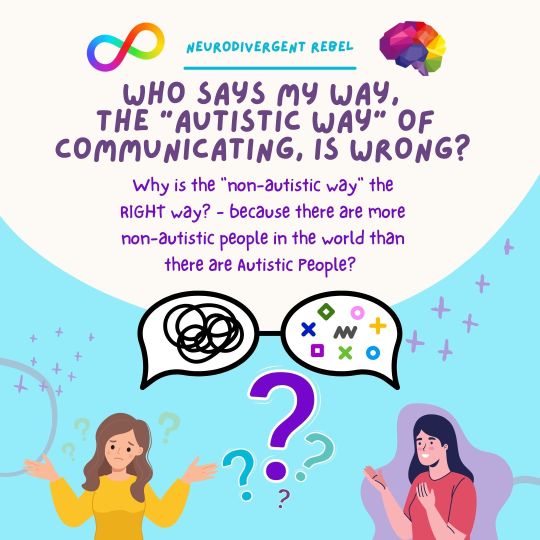
View On WordPress
#actuallyautistic#Autism#autistic pride#double empathy#double empathy problem#empathy#mental health#Neurodiversity
4 notes
·
View notes
Text
Waiting at the hairdresser today and this little kid comes in with his dad, looks at me for a second then quickly looks away, scrunching his eyes up really tight. And instantly it was like - I get you little dude - that's about as much eye contact as I'm comfortable with too. Every few minutes we'd look at each other, then look away, look, maybe share a hint of a smile, look away again... It was a nice, chill, wordless interaction in the middle of the noisy chaos of the salon.
He did the same with the woman sitting on the other side, and she made a comment about him struggling with eye contact. But he & I weren't struggling with anything, all you had to do was match his comfort level. Look, connect, vibe, look away, repeat - easy. This whole "not good with nonverbal social queues" thing goes both ways.
1 note
·
View note
Text
The Double Empathy Problem
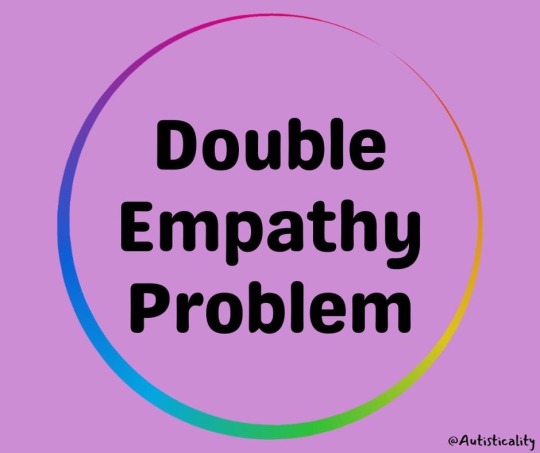
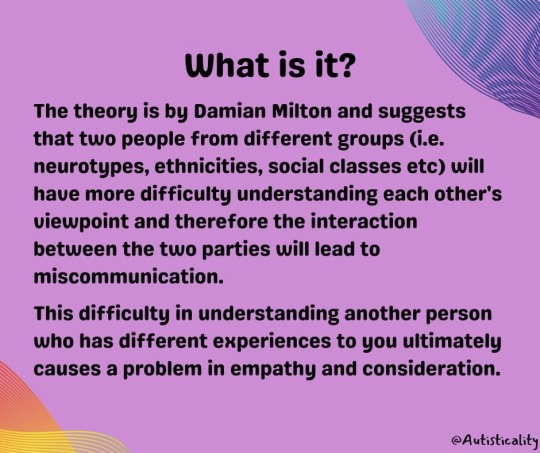



Autisticality
#autism#actually autism#the double empathy problem#empathy#source: Autisticality (Facebook)#feel free to reblog/share#tw bright colors#tw eye strain
217 notes
·
View notes
Text
The "double empathy problem" doesn't apply to all Autistics.
They are called "social communication deficits/impairements" for a reason.
Some of us will struggle regardless of whether a person has Autism or they don't. That's just part of having Autism.
That doesn't make us "broken" or the "wrong" kind of Autistic. And anyone who tries to tell you you're "lying" or "just don't understand what the double empathy problem really means/is about", either doesn't know much about Autism or they're ableist.
#autism#actually autistic#autistic#actuallyautistic#double empathy problem doesn't really apply to me#autism or no autism ima struggle regardless#im actually kinda sick of hearing about this and how its supposed to apply to all of us
38 notes
·
View notes
Text
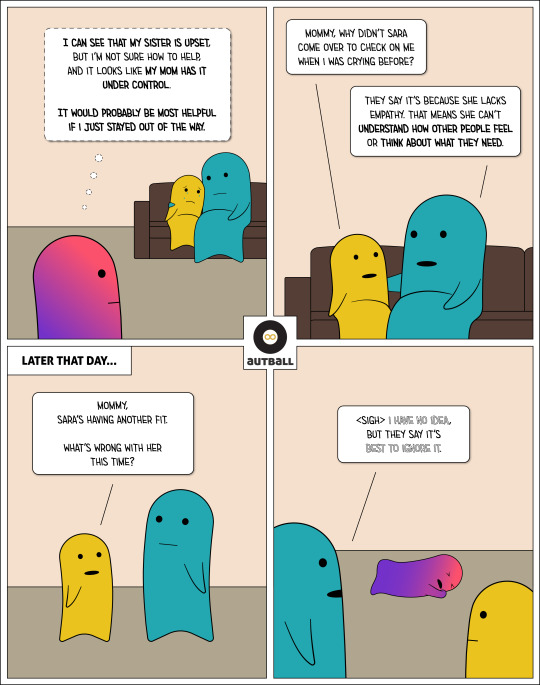
There’s definitely a lack of empathy going on with *someone* here…
More to come on autistic empathy this week, because it's such a biggie. In the meantime, you can learn more about the double empathy problem here: https://reframingautism.org.au/miltons-double-empathy-problem-a-summary-for-non-academics/
#autistic community#autistic#actually autistic#autistic experiences#autistic feels#autistic problems#double empathy problem#empathy#autism acceptance#autistic artist
765 notes
·
View notes
Text
I don’t have deficit in social interaction, it’s others who distance themselves from me whenever I chase them to be my friends with my special interests
20 notes
·
View notes
Text

verbal
#autism#adhd#masking#neurodivergent#double empathy problem#double empathy#audhd#autistic masking#social anxiety#verbalizing thoughts#moomatahiko#naominoop#naominoop art
36 notes
·
View notes
Text
The Double Empathy Problem in the Workplace: More Autistic Employees Accurately Interpret the Behavior of an Autistic Employee Than Non-Autistic People
The Double Empathy Problem and Perceptions of an Autistic Employee in the Workplace by @KASzechy et al found that more autistic employees accurately interpret the behavior of an autistic employee than non-autistic people
Autism In Adulthood on Twitter
“Autism and Employment Challenges: The Double Empathy Problem and Perceptions of an Autistic Employee in the Workplace” offers more validation of…

View On WordPress
5 notes
·
View notes
Text
(i don’t know if OP is autistic or not, but) i really wish people stop generalizing level 1 autistic experiences & research on level 1 autistics to all autistic people…
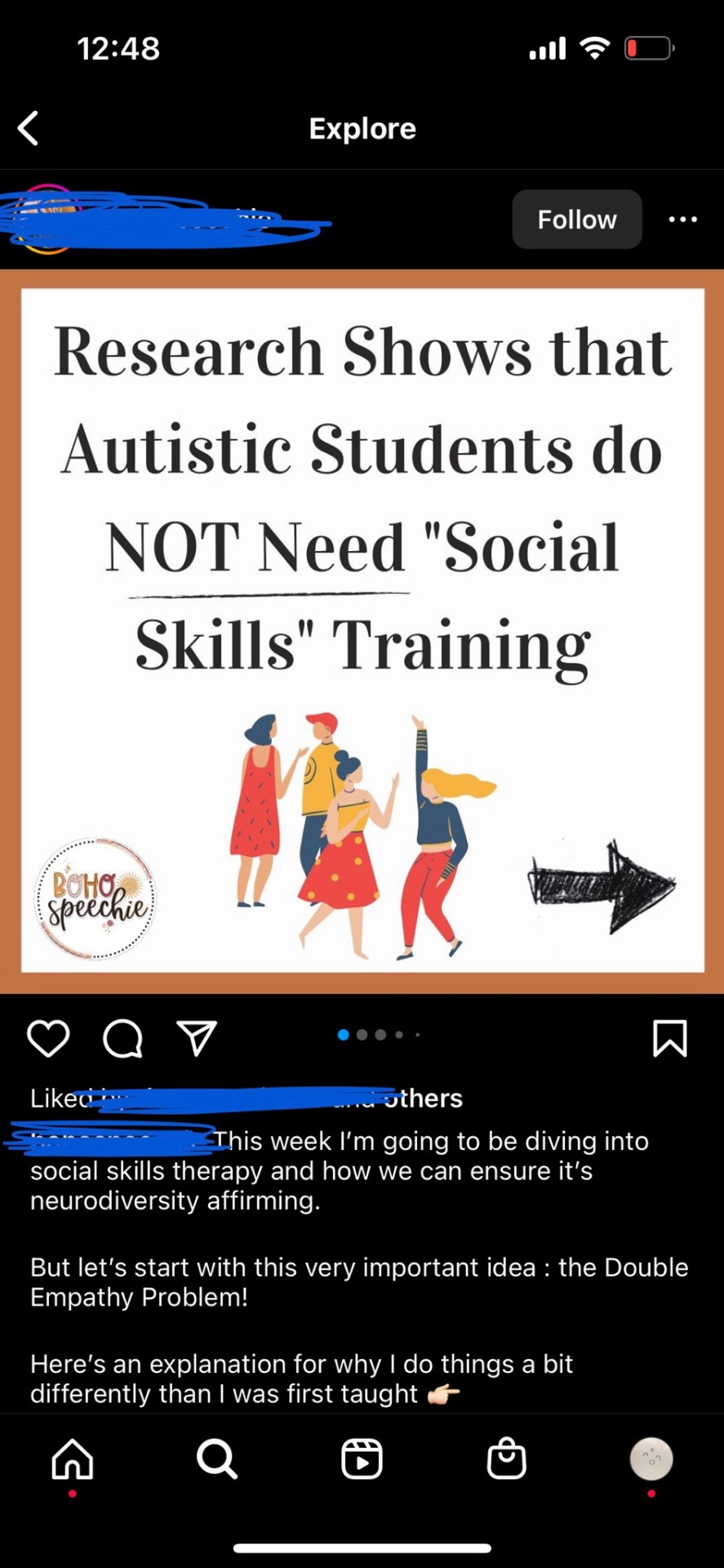
[id: an instagram screenshot with the OP’s irl blurred out. the post image reads “research shows that autistic students do NOT need “social skills” training.” the caption reads: “This week I'm going to be diving into social skills therapy and how we can ensure it's neurodiversity affirming. / But let's start with this very important idea : the Double Empathy Problem! / Here's an explanation for why I do things a bit differently than I was first taught” end ID]
i am angry. this is vile. that probably sound like exaggeration overreaction but i see this countless times and i am let down again and again erased spoken over treated as if don’t exist shouldn’t exist treated as if monster. —not saying this creator is vile or a bad person, but saying this trend is absolutely vile.
(some) level 1 autistics may not need “social skill training,” (some) level 1 autistic’s social troubles may be explained entirely by double empathy problem.
but what about me? what about us? what about those with level 2/3 in DSM criteria A “Persistent deficits in social communication and social interaction”?
i’m so upset i don’t have tangible thoughts
#loaf screm#actually autistic#actuallyautistic#double empathy problem#level 1 autism#level 2/3 autism#level 2 autism#level 3 autism
232 notes
·
View notes